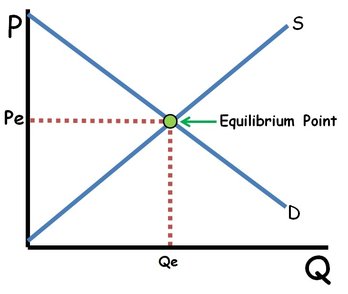
Market Equilibrium
Equilibrium is the point where supply and demand intersect on a graph.
Source: ReviewEcon
At this point, the quantity demanded and quantity supplied are equivalent; it’s an ideal market condition. A huge mistake people often make is saying that “supply = demand,” which is so wrong. It’s about the quantities being equal, not supply and demand themselves.
More often than not, the world is not perfect and the market is not in equilibrium.
A surplus is equal to the absolute value of the difference between quantity supplied and quantity demanded when the market price is above equilibrium, while a shortage is the same thing but when the price is below equilibrium.
Ceteris paribus was touched on at the end of the video, but the implication is this: when analyzing a change in supply or demand, you should assume that nothing else changes – even if there is a logical spillover effect. Some events may actually cause a shift in both supply and demand. Here, the impact on equilibrium is much harder to predict because it depends on the magnitude of each shift. For example, if supply increases while demand decreases, the equilibrium price will certainly decrease. That’s because both a supply increase and a demand decrease independently result in price decreases. However, the impact of the simultaneous shift on the equilibrium quantity will be indeterminate. That’s because a supply increase INCREASES quantity while a demand decrease DECREASES quantity.
